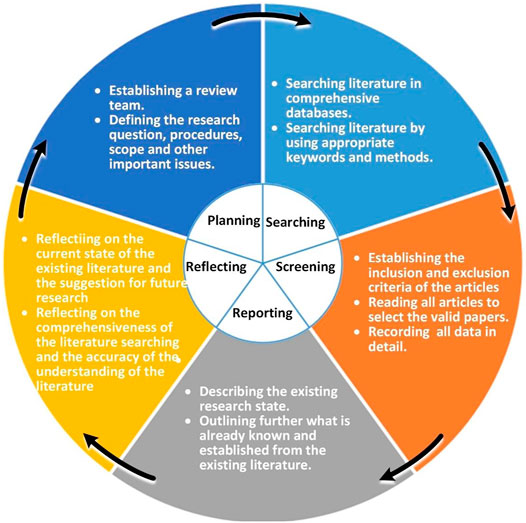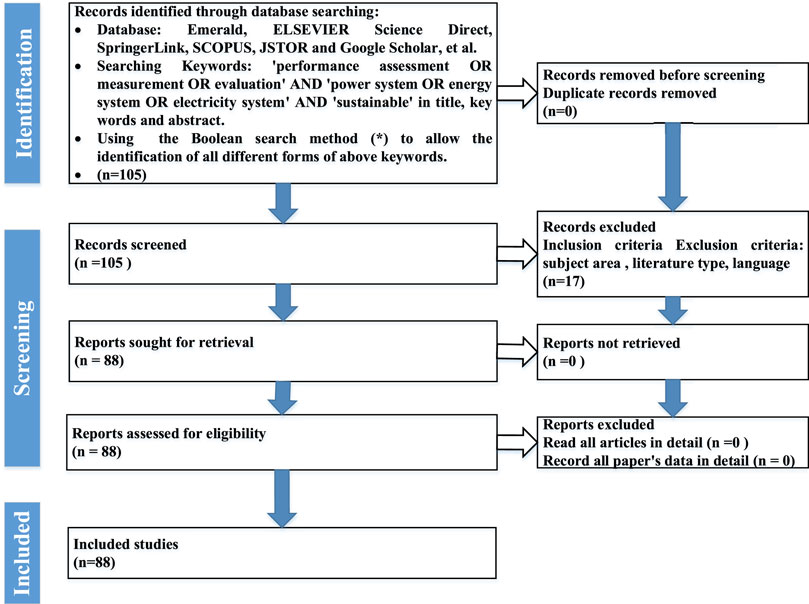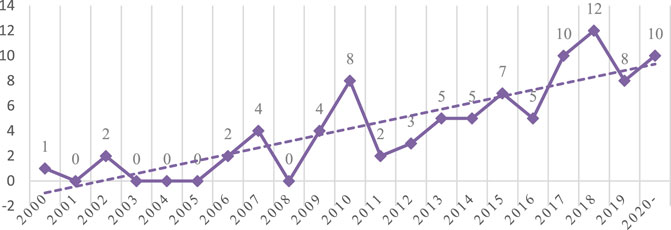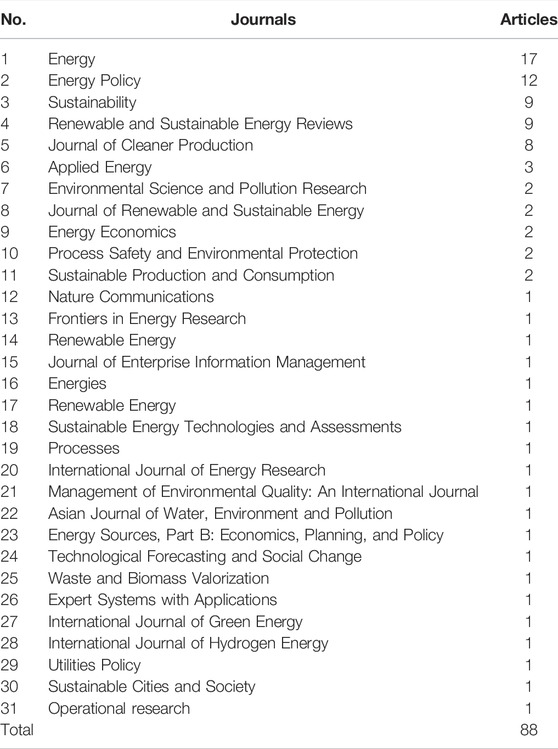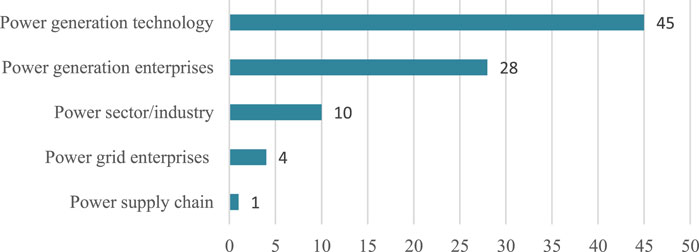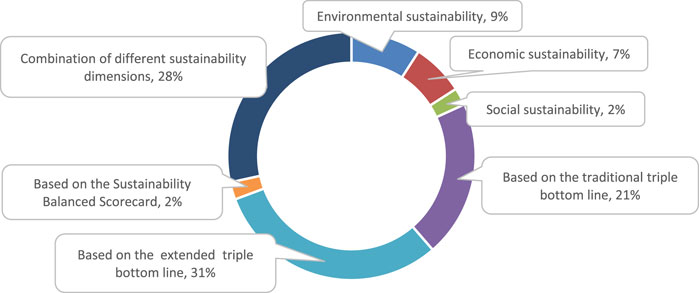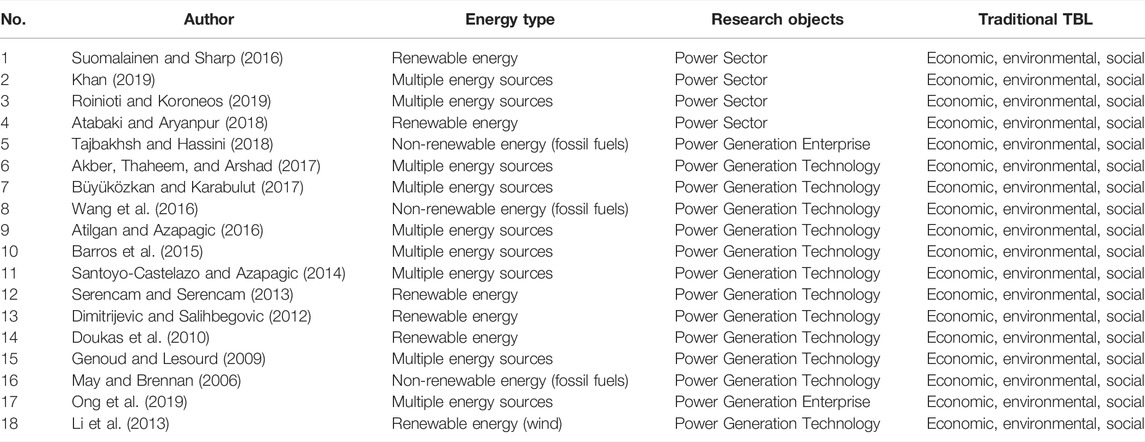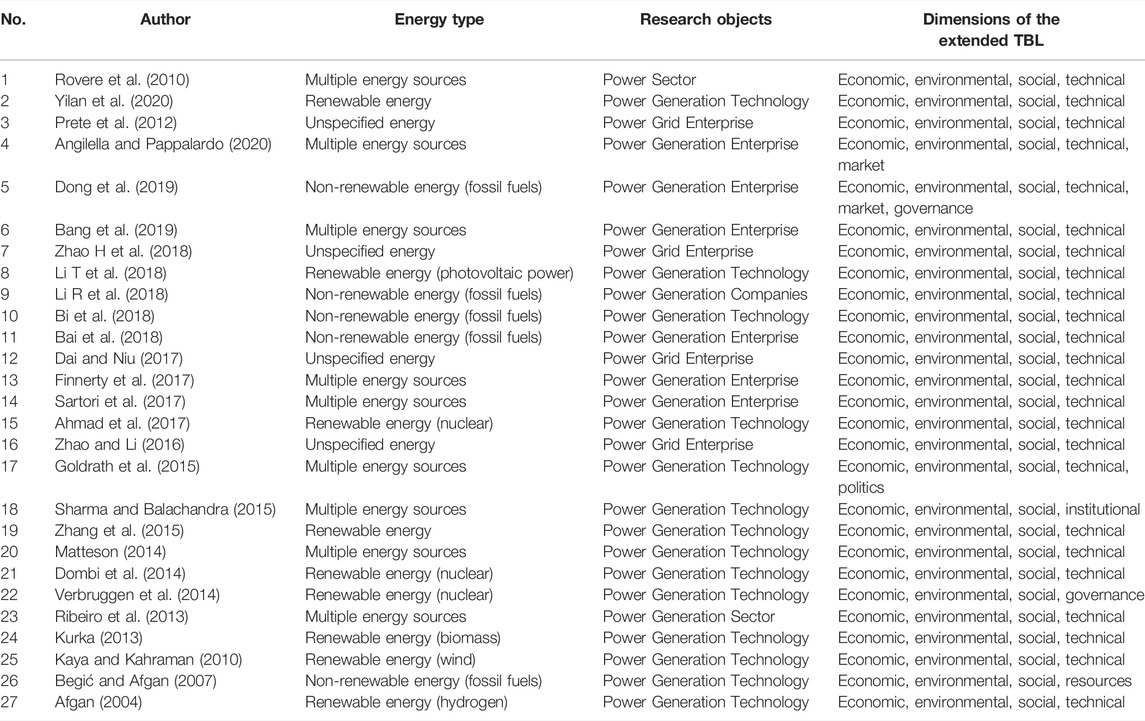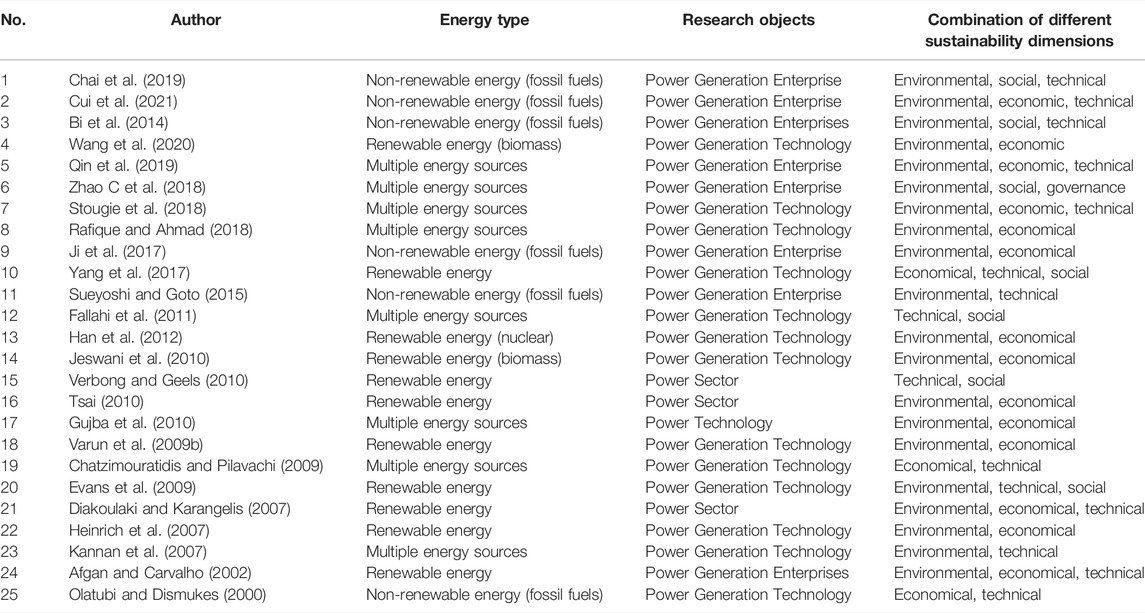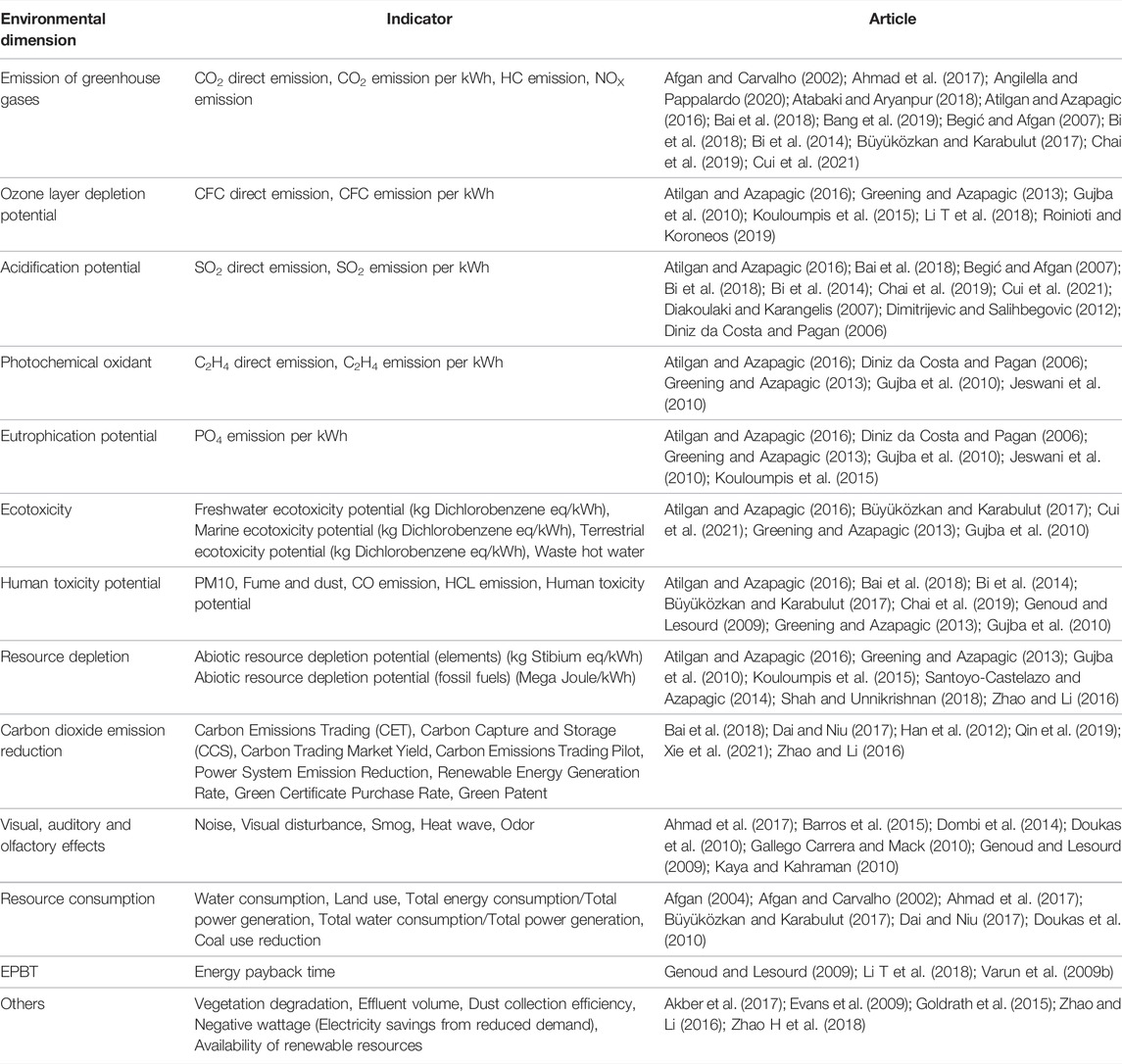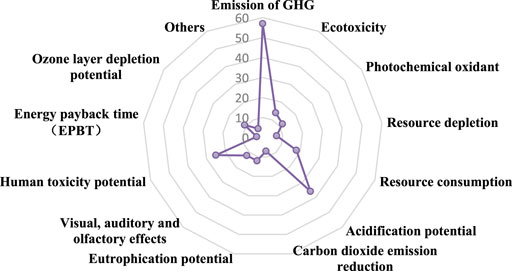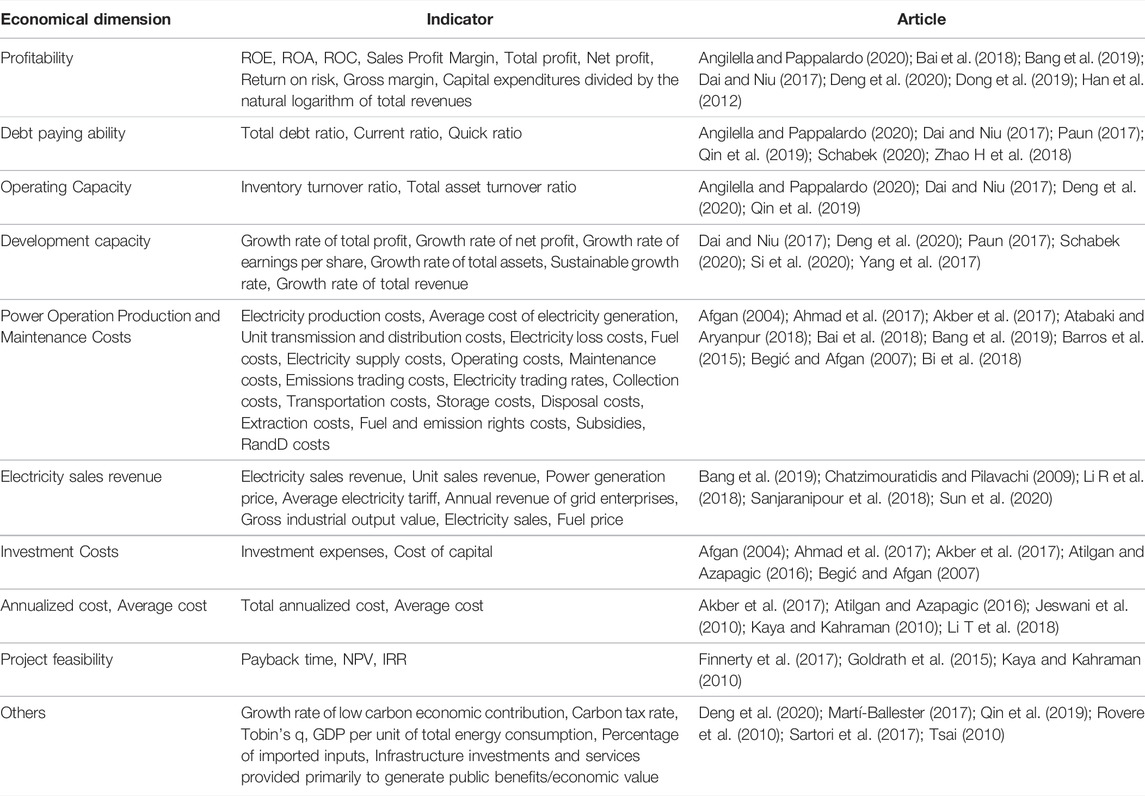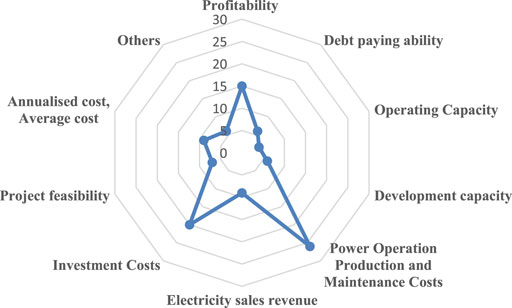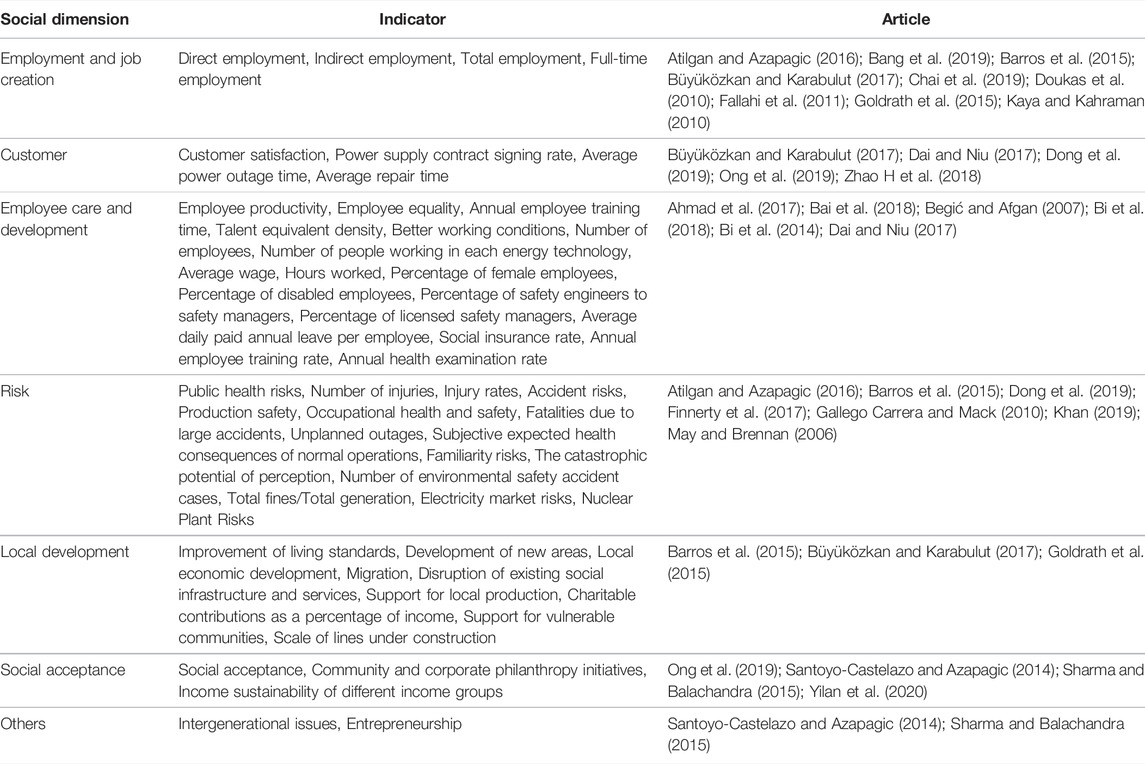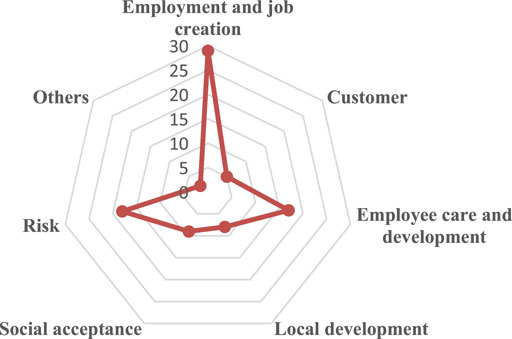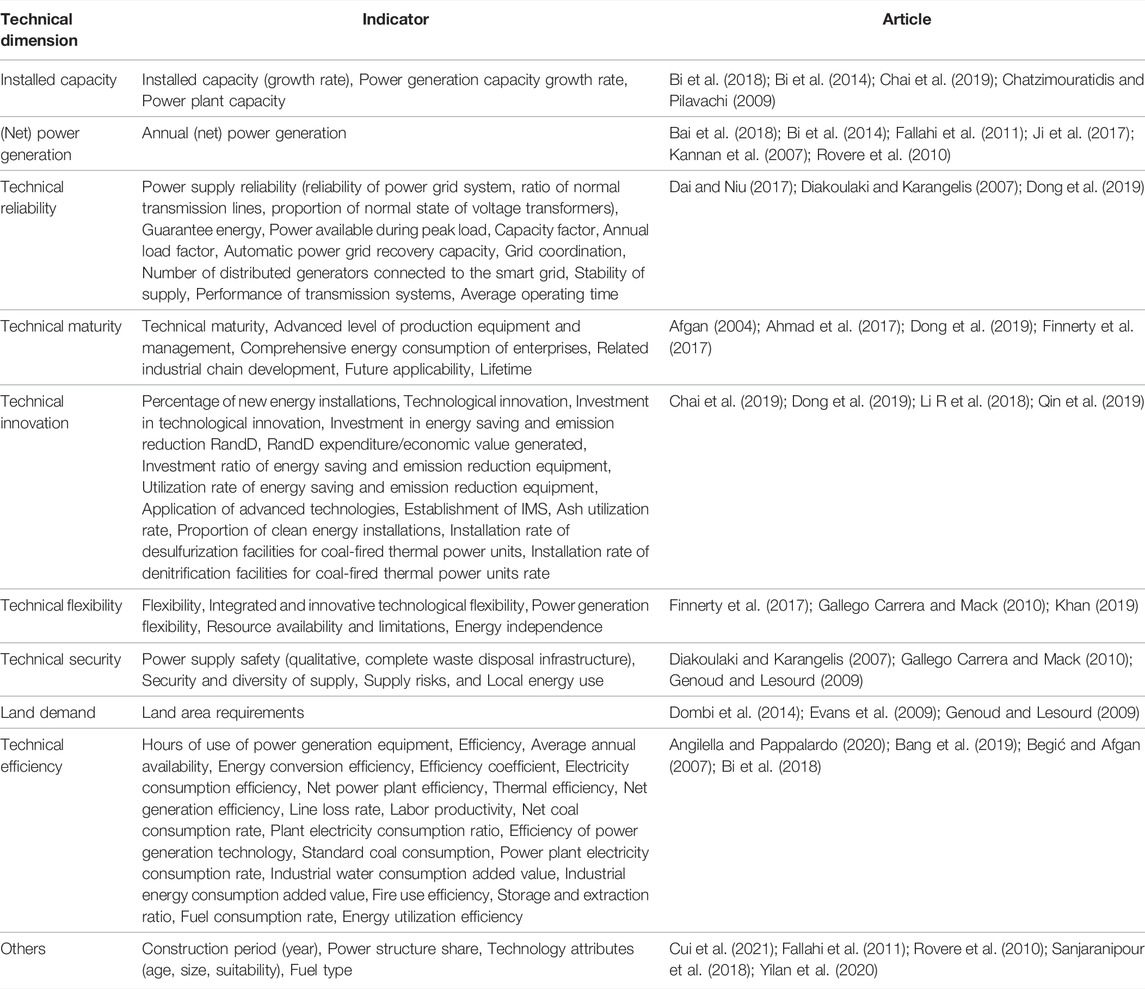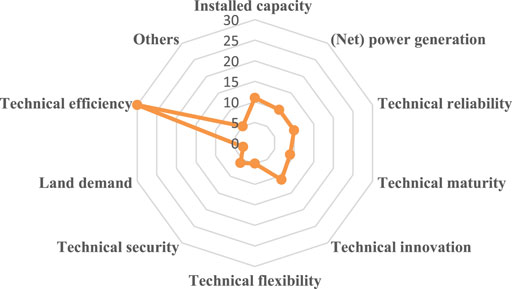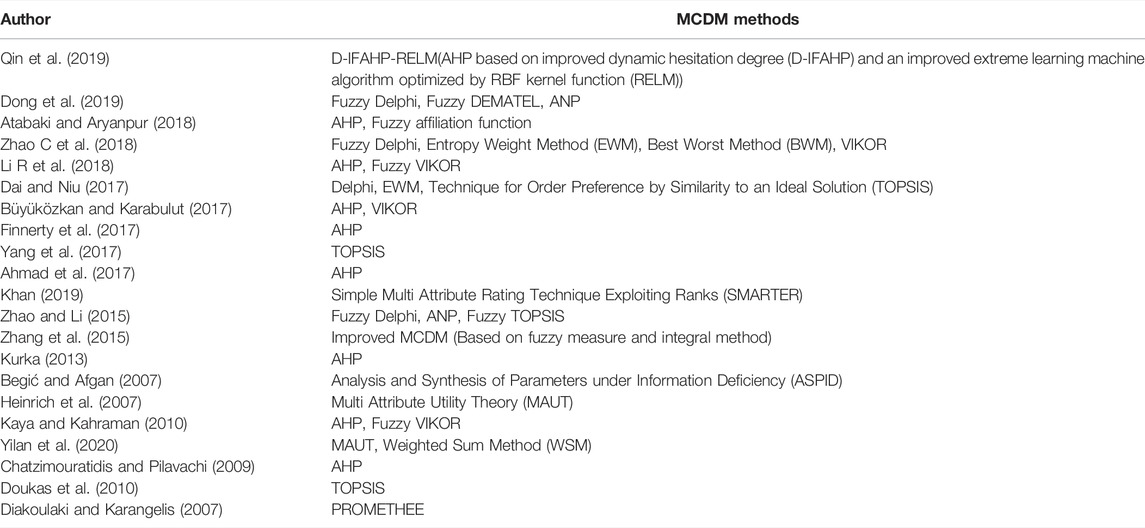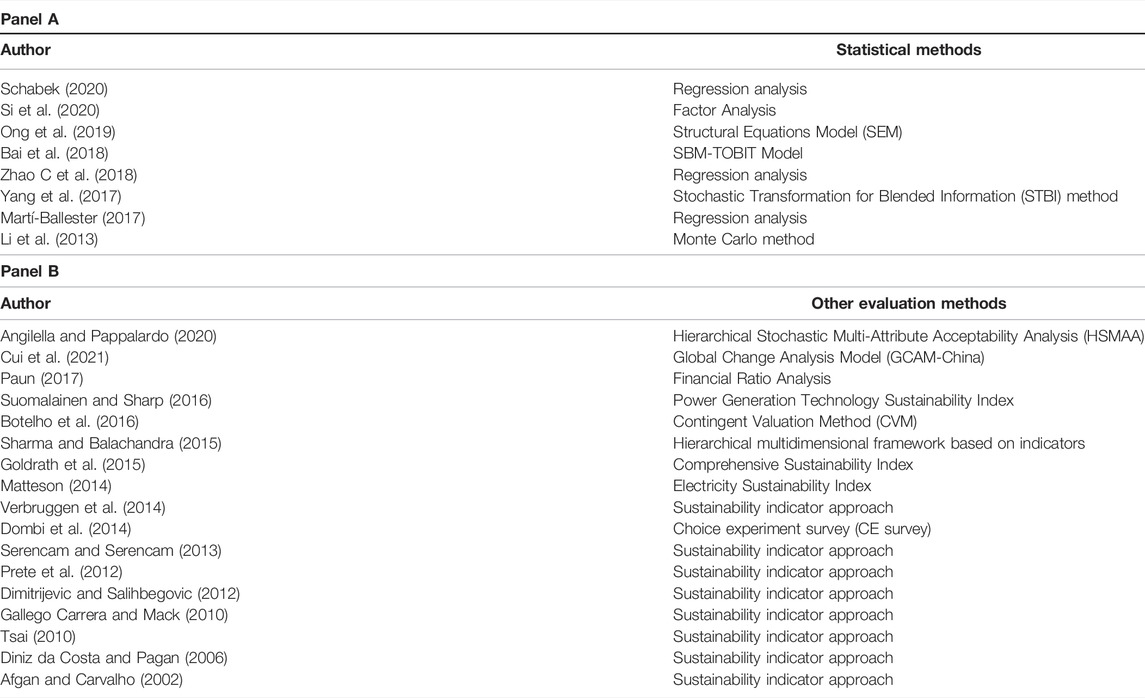- 1College of Economics and Management, Nanjing Forestry University, Nanjing, China
- 2School of Economics and Management, Nanjing University of Science and Technology, Nanjing, China
- 3Business School, Newcastle University, Newcastle upon Tyne, United Kingdom
- 4School of Accounting, Nanjing Audit University, Nanjing, China
Sustainability is a comprehensive concept that integrates at least three dimensions of environment, economy and society. The power system is the primary source of greenhouse gas emissions, adversely impacting environmental sustainability. It also generates necessary energy supplies, which promote economic and social sustainable development. Based on the sustainability nature of power system, this study puts forward an improved methodology, namely “Planning-Searching-Screening-Reporting-Reflecting” (PSSRR Cycle) to review the literature systematically on power system performance evaluation from a sustainability perspective over the past 20 years, with the aim of describing the current state of the whole performance evaluation system including the evaluation framework, evaluation indicators and evaluation methods, and providing research suggestions for future research. This study finds in the current literature that the Triple Bottom Line theory is the most commonly used theoretical evaluation framework; environmental and economic sustainability indicators are more emphasized; the DEA and MCDM methods are the more common evaluation methods. This study presents some future research notes, including improving the Sustainable Balanced Scorecard as a sustainable performance evaluation framework, emphasizing more social sustainability indicators, and using a combination of existing evaluation methods to make performance evaluation more efficient and accurate.
1 Introduction
Driven by the deteriorating ecological environment, social change, and the attendant public interest, sustainability is becoming a key topic of discussion among the general public, governments, enterprises and academic scholars. There are many definitions of sustainability, among which one of the most widely accepted preliminary definitions was presented in the 1987 United Nations report “Our Common Future,” namely, “development that meets the needs of the present without compromising the ability of future generations to meet their own needs” (WCED, 1987). Since then, many dimensions of sustainability have been developed and discussed. In the late 1990s, the British scholar Elkington coins the phrase Triple Bottom Line (TBL), which measures sustainability by integrating the three dimensions of economic, environmental and social sustainability. That is, organizations pursuing their development require balanced development in economic prosperity, environmental protection and social welfare (Elkington, 1997). The first dimension of sustainability is about the environment. Since the 1980s, environmental issues have become crucial to global sustainable development. Goodland (1995) puts forward the term environmental sustainability to refer to protecting human well-being by conserving natural resources and ensuring that the capacity to deal sustainably with human waste products is not exceeded. Diesendorf (2000) also states that environmental sustainability means that natural resources must be not harvested faster than regenerated. The second dimension of sustainability is about society. Social sustainability includes the concepts of equity, empowerment, accessibility, participation, cultural identity and institutional stability (Daly, 1992). Saith (2006) argues that appropriate healthcare, education, gender equality, peace, and stability need to be used globally to promote social sustainability. Economic sustainability is the third dimension. Lobo et al. (2015) regard economic sustainability as a system of production that meets current levels of consumption without compromising future demand. Sheth et al. (2011) identify two different aspects of the economic dimension of sustainability, i.e., traditional financial performance and external economic benefits.
Power system has a significant impact on environmental, social and economic sustainability. Firstly, in terms of environmental sustainability, the carbon emission of power system accounts for more than 40% of total global carbon emissions due to over-reliance on fossil energy (Climate Watch, 2021), which has had a massive impact on global climate change. Meanwhile, other gases produced by the power system also cause severe air pollution. For example, coal-fired power plants in China have caused severe pollution, resulting in large amounts of dangerous smog engulfing northern China (Spegele and Abkowitz, 2015). Secondly, as for social sustainability, the value brought by the power system has permeated all aspects of people’s social life. Any failure of the power system will profoundly endanger the well-being of people and communities. For example, millions of homes and business entities were left without electricity, making millions of people live in the dark and cold due to a blizzard that devastated Texas in the United States (Tribune, 2021). Thirdly, with regard to economic sustainability, the power system provides the electrical energy necessary for modern economic development. There is also a clear causal relationship between the production and consumption of electricity and the country’s economic development and prosperity (Shiu and Lam, 2004; Ayres et al., 2007). Due to the power system’s impacts on sustainability and performance management requirements, it is crucial to understand the whole picture of performance evaluation of power system from the sustainability perspective. Therefore, a systematic literature review can be a suitable approach to acquire comprehensive knowledge and critical inspiration on the sustainability performance evaluation system of power system.
The notable difference from previous literature reviews is that this study evaluates existing literature on the performance evaluation system of power systems from three aspects, i.e. evaluation framework, evaluation indicators, and evaluation methods, which compose the whole performance evaluation system of the power system. Although there are a few existing literature reviews on the power system performance evaluation from the sustainable perspective, they only summarize one part of the performance evaluation system of the power system. For example, Wang et al. (2009) focus on an overview of Multi-Criteria Decision Making (MCDM) tools in sustainable energy decision-making. Martín-Gamboa et al. (2017) discuss the combined use of Life Cycle Assessment (LCA) and Data Envelopment Analysis (DEA) methods in the sustainability assessment of power system. Campos-Guzmán et al. (2019) conduct a comprehensive literature review of the sustainability assessment method of renewable energy system over the past decade (2007–2017), which suggest that a methodological framework combining LCA and MCDM is the appropriate method for the sustainability assessment of renewable energy system. Varun I. K. et al. (2009) also review the application of LCA methods for renewable energy generation systems. These above literature reviews make some distinct contributions for summarizing the evaluation methods of performance evaluation system of power systems. However, they are more concerned with the evaluation methods and less concerned with other vital parts of the performance evaluation system of the power system, such as the evaluation framework and evaluation indicators.
Therefore, in this paper, a systematic literature review concerning the whole performance evaluation system of power system, with the aim of describing evaluation framework, evaluation indicators and evaluation methods, has been performed from the sustainability perspective during the past 20 years (2000–2020). This paper presents not only a holistic and systematic literature review to fully understand the current research status on the power system performance evaluation, but it also provides some critical inspiration and discussion for future research on the performance evaluation of the power system.
The rest of the paper is organized as follows with Section 2 spelling out a new systematic literature review methodology. Sections 3–5 show some description and discussion on the evaluation framework, evaluation indicators and evaluation methods of the power system’s performance evaluation system. Section 6 presents a critical discussion for future research and a conclusion.
2 Research Methodology
This paper adopts a systematic approach to implement the literature review. A systematic literature review is defined as an objective, transparent and complete method (Tranfield et al., 2003; Cook et al., 1997). Precisely, a systematic literature review consists of a thorough search for outstanding contributions to a specific topic, which are assessed and synthesized according to a predefined and precise methodology. A series of specific stages are carefully implemented to ensure the validity and reliability of the literature review. Based on the systematic literature analysis framework proposed by Tranfield et al. (2003), we put forward an improved methodology, namely “Planning-Searching-Screening-Reporting-Reflecting” (PSSRR Cycle, as shown in Figure 1), with five stages that form an integral logical loop.
2.1 Planning
The first stage of a systematic literature review is to plan. According to the study by Tranfield et al. (2003) and Zhang et al. (2019), we form a review team consisting of three scholars on power system’s performance evaluation research and three senior practitioners on power system’s performance evaluation and management. The review team define the research questions and solution ideas as follow after three-round discussions:
Q1. What are the current state and the trend of research on the performance evaluation of power system from the sustainability perspective?
This question will be answered through several steps: firstly, the existing literature will be searched by using appropriate keywords and methods in some databases as comprehensive as possible. Secondly, each article will be studied to find some features common to each piece of research literature and considered for inclusion in the thematic analysis. Thirdly, each article will be identified, and the research state of power system’s performance evaluation from the sustainability perspective will be summarized. Furthermore, the evaluation framework, evaluation indicators, and evaluation methods for performance evaluation of power system will be critically discussed in detail.
Q2. What are the possible research notes of the power system performance evaluation from the perspective of sustainability in the future?
This question will be resolved according to the answer of the former question. Firstly, after a dedicated thematic analysis, what is valuable about each article (e.g. sustainable relevance, evaluation framework, evaluation indicators and evaluation methods used) will be identified and summarized. Then, after reading all the literature, each member of our review team will bring forward valuable conclusions and discussions from existing studies. Finally, after a consensus consultation of the review team, the different views will be consolidated. Then, some discussions and future research suggestions will be conducted and re-refined to stimulate and support the in-depth future research on the sustainable development of power system.
2.2 Searching
Tranfield et al. (2003) argue that comprehensive, unbiased literature searching is one of the fundamental differences between the traditional literature review and the systematic literature review, which means the literature searching requires considerable time, patience and attention to the details (Bom et al., 2019; Araujo et al., 2020). Our systematic literature searching begins with the identification of search keywords based on the scope of this study. Then, we decide on the searching keywords that were most appropriate for this study.
During the searching stage of this study, we make literature searching from Emerald, ELSEVIER Science Direct, SpringerLink, SCOPUS, JSTOR and Google Scholar, et al. The searching keywords include “performance assessment OR measurement OR evaluation” AND “power system OR energy system OR electricity system” AND “sustainable” which are limited to the article title, keywords and abstract. The searching is extended by using the Boolean search method (*) to identify all different forms of the above keywords. Finally, A total of 105 articles over the last 20 years are collected.
2.3 Screening
Tranfield et al. (2003) point out that the output of the literature searching should be a complete list of articles that is the basis of the literature review. Therefore, we screen those articles that meet all the inclusion criteria specified in the review protocol (Milanesi et al., 2020). More than one author conducts this stage of this systematic review because whether articles should be included or excluded is relatively subjective. The disagreements about the literature screening are discussed and resolved by the review team.
In the screening stage of this study, we carefully screen the articles for in-depth analysis based on our inclusion and exclusion criteria (as shown in Table 1). All articles are read carefully by every author. Conference papers, book chapter sections (8 articles), and literature reviews (9 articles) are excluded. Finally, after literature screening, the remaining 88 articles on the power system’s performance evaluation are listed in an Excel workbook, which records all papers’ data in detail. The searching and screening process can be summarized in the PRISMA flow chart (as shown in Figure 2).
Eighty-eight articles are finally identified as shown in Figure 3. After a plodding start, research on this topic is generally in a state of growth. Although there are some fluctuations, it is clear that academic interest in this issue has increased rapidly over the last few years. We may suggest at least three plausible reasons as follow. Firstly, in the light of the current carbon reduction targets proposed by countries around the world and the profound effect caused by climate change, there is a growing social awareness of the power system as a major source of carbon emission. Secondly, due to the rapid development of new energy technologies, scholars pay more and more attention to the contribution of technology to the sustainability of power system. Thirdly, the power system has an irreplaceable role in the development of national economies and societies.
Table 2 displays an overview of the articles published by journals. Energy and Energy Policy are the two most published journals on the performance evaluation of power system from the perspective of sustainability, both of which have titles related to energy, consistent with their aim of addressing and discussing sustainability issues. Figure 4 illustrates our ranking of the number of specific research subjects within the power system. It can be observed that most of the existing studies focus on the sustainability evaluation of power generation technologies and power generation enterprises, while there are fewer studies on the sustainability evaluation of the power supply chain. Figure 5 demonstrates the percentage of the screened literature that examines the number of different energy types. It is striking to see that the literature examining the sustainability of power generation from multiple energy sources is more predominant, followed by the literature examining the sustainability of power generation from renewable energy sources separately.
2.4 Reporting
A successful systematic review should produce a clear report which can make the research more accessible to the readers by synthesizing a wide range of original research papers. The report firstly focuses on identifying the key themes and the degree of consensus between these different themes. Furthermore, the report outlines what is already known and established from the existing literature Tranfield et al., 2003; Zhang et al., 2019; Milanesi et al., 2020. In this paper, we synthesize the selected articles so that the core contributions of the different articles. Then, the evaluation framework, evaluation indicators and evaluation methods as the three main themes of the power system’s performance evaluation system are discussed in detail.
2.5 Reflecting
Based on the systematic literature analysis framework that Tranfield et al. (2003) proposed, we add a Reflecting stage to form an integral logical loop. There are two parts in this stage as follow: firstly, reflecting critically on the current research state and the suggestion for future research; and secondly, reflecting on the limitations of this systematic review, with a focus on the comprehensiveness of the literature search and the accuracy of the understanding of the literature.
3 Evaluation Framework
The evaluation framework for performance evaluation refers to the conceptual dimensions of performance. Based on the existing literature, we have divided the evaluation framework into two categories from the sustainability perspective. The one is the evaluation framework with a single sustainability dimension, such as environmental, economic and social sustainability dimension. The other is the evaluation framework with multiple sustainability dimensions, which includes traditional triple bottom lines, extended triple bottom lines, sustainable balanced scorecards and a combination framework of different sustainability dimensions. As shown in Figure 6, the proportion of the articles based on the evaluation framework with a single sustainability dimension is about 18%. About 82% of the articles are based on the evaluation framework with multiple sustainability dimensions. Among them, papers based on TBL and expanded TBL account for more than 52%.
3.1 Evaluation Framework With a Single Sustainability Dimension
3.1.1 Single Environment Sustainability
About 9% of the articles adopt a single environmental sustainability evaluation framework. Firstly, some articles have made attempts in research methods. For example, Xie et al. (2021) use a Data Envelopment Analysis (DEA) game cross-efficiency model combined with a Malmquist index approach to study the dynamic environmental performance of Chinese power generators. Kouloumpis et al. (2015) present a combination of the life-cycle approach and scenario analysis to explore the impact of expected decarbonization of electricity supply on other environmental performance. Secondly, some scholars have explored the environmentally sustainable performance of power systems in the context of energy policy changes. For example, Zhang (2019) and Kaygusuz (2011) discuss the environmental sustainability performance of the power system in the circumstances of energy policy changes in China and Turkey. In addition, some scholars have explored the environmental sustainability performance of power system under certain energy technologies. For instance, Greening and Azapagic (2013) have explored the environmental sustainability performance of micro-wind turbines and the potential role in helping the UK meet its climate change targets. Diniz da Costa and Pagan (2006) evaluate the environmental sustainability performance of coal power generation in Australia. Shah and Unnikrishnan (2018) assess the environmental impacts of natural gas-fired power generation in India. The sustainability performance of the electricity supply chain in 24 Chinese provinces are evaluated mainly from the environmental perspective in the study by Sun et al. (2020).
3.1.2 Single Economic Sustainability
Some articles directly use financial indicators to evaluate the economic sustainability performance of the power system. For example, Zhang and Qi (2020) use economic indicators such as carbon economic efficiency to evaluate the economic sustainability performance of the Chinese wind power industry. Si et al. (2020) utilize financial indicators such as short-term profitability, long-term profitability and RandD investment to evaluate economic sustainability performance. Employing financial metrics such as ROE and ROA, Schabek (2020) indicates solar power producers outperforms wind power by examining the economic sustainability performance of renewable energy companies from 16 emerging markets over the period 2000 to 2017. Paun (2017) also employs some financial indicators such as ROE and ROA to evaluate the economic sustainability performance of the renewable energy sector in Romania. Martí-Ballester (2017) applies ROE, Tobin’s Q and other financial indicators to evaluate economic sustainability performance. Deng et al. (2020) construct a financial performance evaluation system for nuclear-related enterprises from a sustainability perspective.
3.1.3 Single Social Sustainability
Only two articles assess the social sustainability of energy systems. Botelho et al. (2016) evaluate the social sustainability of renewable energy production facilities by using social indicators such as public familiarity with renewable energy generation facilities, the visibility of renewable energy generation facilities, and public opinion of renewable energy generation facilities. Gallego Carrera and Mack (2010) evaluate the social sustainability of energy technologies from stakeholders’ perspectives by applying some social indicators, such as security and reliability of energy supply, political stability and legitimacy, social and personal risk and quality of life.
3.2 Evaluation Framework With Multiple Sustainability Dimensions
3.2.1 Traditional Triple Bottom Line
About 21% of the selected articles are based on the Triple Bottom Line. For example, Suomalainen and Sharp (2016) describe the shift of renewable energy policy in New Zealand and assess the sustainability performance of the power sector based on the TBL. Khan (2019) evaluate the sustainability performance of the Bangladesh Power System Master Plan through a multi-criteria decision analysis model using the social, environmental and economic dimensions of the TBL sustainability framework. This article notes that energy policy design needs to balance all three dimensions to ensure a sustainable power generation system in the future. Table 3 summarizes these articles using the traditional TBL to evaluate the performance of power system.
3.2.2 Extended Triple Bottom Line
Extended Triple Bottom Line is the most commonly used evaluation framework for power system performance evaluation. Extended Triple Bottom Line extends the TBL by adding some characteristics of power systems, i.e. technology, as a new extended dimension into the traditional TBL framework. For example, Rovere et al. (2010) extend the traditional triple bottom line framework by integrating four dimensions, i.e., social, economic, environmental and technological dimensions to evaluate the performance of small-scale hydro, wind, natural gas and nuclear power generation types. Similarly, for sustainable energy decision-making, Yilan et al. (2020) consider the economic, technical, environmental and socio-economic criteria to compare the performance of seven major power generation technologies in Turkey. In addition, some articles add to the traditional TBL framework by considering other dimensions such as Resources, Markets, Politics and Corporate Governance, etc. It describes these articles using the extended TBL to evaluate the performance of the power system in Table 4.
3.2.3 Sustainable Balanced Scorecard
The Balanced Scorecard is a performance measurement and management system designed to balance financial and non-financial, short and long-term measures. A modification of the original Balanced Scorecard explicitly takes into account the environmental, social or ethical issues, which is referred to as Sustainable Balanced Scorecard (SBSC) (Hansen and Schaltegger, 2016). SBSC is widely used in sustainability performance evaluation (Deng et al., 2018; Mio et al., 2021). Only two papers are using the SBSC to measure the sustainable performance of power systems. For example, Sanjaranipour et al. (2018) measure the performance of the Iranian thermal power plant based on the SBSC framework. Based on the principles of the SBSC, Zhao and Li (2015) add the dimensions of Environment and Sustainability to the traditional BSC to assess and rank the performance of four power generation groups in China. A summary of these two articles using the SBSC is shown in Table 5.
3.2.4 Combination of Different Sustainability Dimensions
In this section, many articles assess the performance of power systems by relatively freely choosing an appropriate evaluation framework with a combination of different sustainability dimensions. This evaluation framework may include one or two sustainability dimensions of the TBL and other sustainability dimensions, such as technical sustainability, social sustainability, etc. For instance, Chai et al. (2019) evaluate the performance of listed companies in the thermal power sector by using an evaluation framework with the combination of different sustainability dimensions including the Technical dimension and the Environmental, Social dimensions, that stem from the traditional Triple Bottom Line. As shown in Table 6, few articles deal with the social dimension in the combination of the different sustainability dimensions, while almost every article concerns environmental sustainability.
4 Evaluation Indicators
4.1 Environmental Sustainability Indicators
The environmental sustainability indicators can be divided into 13 indicator categories, as shown in Table 7. In the articles selected in this paper, a total of 57 papers take Greenhouse Gas Emissions as their environmental sustainability indicator, which means Greenhouse Gas Emissions is the most considered environmental sustainability indicator. This finding is in line with the study of Campos-Guzmán et al. (2019). The next more considered indicator categories are Acidification Potential and Human Toxicity Potential. The former includes sulfur dioxide emissions and their impact on atmospheric acidification. The latter includes emissions of harmful pollutants to human health (e.g., respirable particulate matter, carbon monoxide, etc.). The summary of environmental sustainability indicators and the frequency of each indicator category are shown in Figure 7.
4.2 Economic Sustainability Indicators
The economic sustainability indicators can be divided into 10 indicator categories, as shown in Table 8. These indicators are mainly profitability indicators and cost-based indicators, which reflect how limited economic resources are allocated. Figure 8 describes the summary of economic sustainability indicators and the frequency of each indicator category.
4.3 Social Sustainability Indicators
The social sustainability indicators can be divided into seven categories according to whether they are beneficial or harmful to humans, as shown in Table 9. These social sustainability indicators show the issues that directly or indirectly affect the human and society. In most cases, they are qualitative indicators, implying the involvement of the public, experts and authorities. Employment and Job Creation is the most common social sustainability indicator, followed by other indicators such as Employee Care and Development and Risk. The summary of social sustainability indicators and the frequency of each indicator category are shown in Figure 9.
4.4 Technical Sustainability Indicators
According to the indicators used in our selected articles, the technology sustainability indicators consist of 10 categories, as shown in Table 10. Among these indicators, Efficiency is in the leading position, followed by Technical Innovation, Installed Capacity, Technical Reliability. Figure 10 illustrates the summary of technical sustainability indicators and the frequency of each indicator category.
4.5 Other Sustainability Indicators
According to the previous Section 3, there are some other sustainability dimensions in addition to environmental, social, economic, and technical sustainability dimensions. Therefore, it is necessary to summarize the other sustainability dimensions, as shown in Table 11.
5 Evaluation Methods
5.1 Data Envelopment Analysis
In the early 2000s, Olatubi and Dismukes (2000) apply DEA methods to measure the cost performance of coal-fired generation facilities. Rovere et al. (2010) incorporate socio-environmental, technical and economic aspects into the performance evaluation to decide the power generation expansion based on the DEA approach. Fallahi et al. (2011) utilize the DEA methodology to measure efficiency and productivity changes in power generation management companies. Tajbakhsh and Hassini (2018) propose a two-stage DEA model to assess the sustainable performance of thermal power plants. Furthermore, Sun et al. (2020) introduce an improved DEA model to analyze the sustainable performance of Chinese electricity supply chain. Deng et al. (2020) combine DEA methods with MCDM methods such as Analytic Hierarchy Process (AHP) and Preference Ranking Organization Methods for Enrichment Evaluations (PROMETHEE) to study the financial sustainability performance of nuclear power companies. DEA methods are also often used in conjunction with statistical methods, such as Slacks-Based Measure (SBM) analysis (Chai et al., 2019) and Tobit regression analysis (Bang et al., 2019). The summary of the use of DEA methods is shown in Table 12.
5.2 Multi-Criteria Decision Making Method
Due to the multidimensional nature of sustainability goals and the complexity of social, economic, and biophysical systems, Multi-Criteria Decision Making (MCDM) methods are becoming increasingly popular in performance evaluation for power system decision-making (Wang et al., 2009). Chatzimouratidis and Pilavachi (2009) evaluate the technical, economic and sustainability performance of ten types of power plants by applying an Analytic Hierarchy Process (AHP) and find that renewable energy power plants are the best solution for the future. Li R et al. (2018) establish a new hybrid MCDM model by using AHP and fuzzy Vlsekriterijumska Optimizacija I Kompromisno Resenje (VIKOR) method to evaluate the performance of four large power generation companies. Dong et al. (2019) apply the extended MCDM model combined with fuzzy Delphi, Analytic Network Process (ANP) and fuzzy Decision-making Trial and Evaluation Laboratory (DEMATEL) to identify the key influences on the sustainability performance of conventional power generation groups in the market. Table 13 provides the summary of the application of MCDM methods.
5.3 Life Cycle Assessment Method
Life Cycle Assessment (LCA) is an essential environmental management tool. Life cycle refers to the entire process of a product (or service) from the acquisition of raw materials, production, application to disposal. Life Cycle Sustainability Assessment (LCSA) is well suited for assessing environmental, economic and social sustainability (Guinee et al., 2011). Stougie et al. (2018) assess the environmental and economic sustainability of five power generation systems: coal-fired power plants, coal-fired power plants including carbon capture and storage (CCS), biomass power plants, offshore wind farms, and photovoltaic parks. Li R et al. (2018) couple the LCA approach and sustainability theory to propose an integrated sustainability assessment model and then validated the model by applying it to a solar photovoltaics (PV) case study in the northeast of England.
LCA methods are often combined with MCDM methods. Atilgan and Azapagic (2016) combine the LCA approach with MAUT (Multi-Attribute Utility Theory) to assess the integrated life-cycle sustainability of power generators in Turkey. Genoud and Lesourd (2009) apply the LCA method and Elimination Et Choix Traduisant la R Ealité (ELECTRE) approach to evaluate the performance of power technology, such as Reservoir hydroelectricity, natural gas-fired power generation, etc. The articles using the LCA approach in combination with the MCDM approach are shown in Table 14.
5.4 Statistical Methods
The statistical method is a commonly used method of power system performance evaluation in some empirical research. For example, Si et al. (2020) employ factor analysis to investigate the interactive endogeneity relationship between RandD investment and financial sustainability performance and the moderate effect of executive incentives. Ong et al. (2019) conduct a self-administered questionnaire survey of 217 electrical and electronics companies and a hypotheses test through structural equation modelling (SEM) to identify critical success factors for sustainable performance measurement in Malaysian electrical and electronics companies. Yang et al. (2017) posit a new hybrid evaluation index system from sustainability and internal group management perspectives. In addition, the regression analysis method is more often applied to evaluate the economic sustainability performance of power listed companies, such as the articles studied by Schabek (2020) and Martí-Ballester (2017). The summary of relevant articles of application the statistical methods is shown in Table 15, Panel A.
5.5 Other Evaluation Methods
In addition to the above evaluation methods, some other evaluation methods are applied in some articles. For example, Botelho et al. (2016) adopt the Contingent Valuation Method (CVM) to evaluate the social sustainability performance of renewable energy in power generation. Dombi et al. (2014) define seven sustainability attributes to describe the sustainability performance of each renewable energy-based power and heat technology. The weight of these attributes is achieved through a Choice experiment survey conducted among Hungarian professionals. A summary of the application of other evaluation methods is shown in Table 15, Panel B.
6 Critical Inspiration and Conclusion
Based on the above analysis, there are several research notes for future research on the performance evaluation of power systems. Firstly, under the circumstances of advocating global low-carbon development, research on performance evaluation of power systems is shifting from the traditional model to the sustainability model, which expands many research fields in the future. Especially, in order to explore the sustainable transformation and development of clean energy system from sustainability perspectives, performance evaluation of clean energy system is becoming a world research upsurge. Secondly, sustainable performance evaluation of power systems can adopt a combination of some management tools such as the sustainable balanced scorecard (SBSC). The SBSC combines the traditional balanced scorecard and the triple bottom line theoretical framework, combining strategy implementation tools, performance management tools and sustainability concepts. SBSC will vigorously promote sustainable performance evaluation and management practices in power systems. It should be noted that the difficulty of the SBSC lies in how to integrate the triple bottom line with the traditional BSC, which has two solution pathways requiring more rigorous theoretical and practical exploration. The one is to add more sustainability dimensions to the traditional four dimensions of the BSC, and the other is to integrate the sustainability concept into the four traditional BSC framework dimensions. Thirdly, while the environmental and economic sustainability performance of power systems has received widespread attention, the existing literature has paid relatively little attention to the issues of the social sustainability performance of power systems. The stability and safety of the power system have a significant impact on society. Furthermore, the social sustainability performance of the power system is also an essential expression of the power system’s social responsibility. Fourth, given the multidimensional nature and the complexity of the sustainable development of power systems, the MCDM is the most suitable evaluation method for the sustainability performance of power systems. Therefore, finding a suitable MCDM method according to the characteristics of the evaluation object is the critical issue for the performance evaluation of the power system. Future research should pay attention to the hybrid and application of MCDM method and other methods. Finally, in terms of the geographical distribution of research on the performance evaluation of power systems, future research should focus on the sustainable development of power systems in underdeveloped regions such as Africa. Moreover, although solar power, hydroelectric power, wind power and even nuclear power are currently more common research objects, it can be noted that biomass and straw energy has less attention. Therefore, the research of sustainability performance evaluation of power systems can also be broadened into these new fields in the future.
To sum up, this paper put forward a systematic methodology, namely “Planning-Searching-Screening-Reporting-Reflecting” (PSSRR Cycle), to review the articles on power system’s performance evaluation from a sustainable perspective. Some findings are revealed based on three main parts of the power system’s performance evaluation system: Evaluation Framework, Evaluation Indicators, and Evaluation Methods, respectively. Firstly, regarding the evaluation framework, the Triple Bottom Line theory is the most commonly used theoretical framework for evaluating the performance of power systems from a sustainability perspective. Almost all of the articles deal with the environmental aspects, which shows that the environmental sustainability caused by power systems have attracted the attention of the vast majority of scholars. In the Expanded Triple Bottom Line framework, technical sustainability is the most commonly considered aspect. It is worth noting that Evaluation Frameworks of the power system’s performance evaluation system are evolving ceaselessly. For example, a small number of studies have adopted the Sustainable Balanced Scorecard (SBSC) as the Evaluation Frameworks. SBSC is an organic blend of the traditional balanced scorecard and the triple bottom line. SBSC will be a powerful tool for evaluating sustainability performance and implementing the sustainable development strategy. For future research, the SBSC could be considered for sustainability performance evaluation of power systems, with continuous attempts to modify it so that the three dimensions of sustainability can be better balanced and expanded. Secondly, concerning the evaluation indicators, although the indicators used in each article are not the same, there are commonalities in these indicators that reflect which indicators are more commonly applied and valued. To a certain extent, the indicators used more frequently in articles are regarded as the more critical factors to evaluate the power system’s performance. Current research has placed more emphasis on environmental and economic sustainability indicators while neglecting social sustainability indicators. For the future research, the selection of indicators should follow corresponding principles, such as the ease of access to data, the comprehensiveness of the measurement and the high relevance to the content of the measurement, thus enhancing the diversity of the evaluation content. Furthermore, although some indicators are somewhat specific and rare, it does not mean that they are not essential because of the specificity of the research objects, which may also provide a reference for the related research in the future. Finally, as for evaluation methods, the DEA and MCDM methods are the more common performance evaluation methods of power systems. Many scholars can improve the DEA method to make the evaluation process and results more accurate. Many MCDM methods are often selected and efficient combined according to the advantages of these methods. In addition, the LCA method is also essential because it is widely used alone or in combination with DEA or MCDM methods. Although LCA is suitable for the characteristics of the power system, the requirements of data availability and accuracy are very high, which limits the application and development of this method. In the future studies, the use of multi-criteria decision making methods is more strongly recommended. A combination of different evaluation methods can be explored and even more precise evaluation methods can be developed.
The evaluation framework, evaluation indicators, and evaluation methods are the main three aspects of the whole performance evaluation system of the power system. This study distinguishes itself from existing reviews of power system performance evaluation in that it not only focus more on the description of the evaluation methods (e.g., Varun I. K. et al., 2009; Wang et al., 2009; Martín-Gamboa et al., 2017; Campos Guzmán et al., 2019), and it is also more concerned with other aspects of the evaluation system, such as the evaluation framework and evaluation indicators.
Of course, this paper is subject to several limitations. Firstly, although this paper tries to summarize all the evaluation framework, indicators, and methods as far as possible in the thematic analysis section, it is impossible to avoid some omissions. Secondly, some methodological limitations need to be considered when interpreting the study results. For example, book chapters, conference papers and books were excluded in this paper, which potentially creates a bias in the selection of literature. Finally, the keywords choice and literature screening are performed under our subjective conditions in this paper, which may lead to unexpected uncertainty due to the limitations of our knowledge.
Data Availability Statement
The original contributions presented in the study are included in the article/supplementary material, further inquiries can be directed to the corresponding author.
Author Contributions
All authors contributed to the study conception and design. Material preparation, data collection and analysis were performed by DD, CL, and YZ. JZ, SW, and LL commented on previous versions of the manuscript. All authors read and approved the final manuscript.
Funding
The work was supported by the Social Science Fund Project of Jiangsu Province of China (Grant no. 19EYB013), China National Social Science Fund Project (Grant no. 20FJYB026) and Youth Fund of National Natural Science Foundation of China (Grant no. 72102108) and Jiangsu “333 Project” Scientific Research Support Project (Grant no. 2020-18).
Conflict of Interest
The authors declare that the research was conducted in the absence of any commercial or financial relationships that could be construed as a potential conflict of interest.
Publisher’s Note
All claims expressed in this article are solely those of the authors and do not necessarily represent those of their affiliated organizations, or those of the publisher, the editors and the reviewers. Any product that may be evaluated in this article, or claim that may be made by its manufacturer, is not guaranteed or endorsed by the publisher.
References
Afgan, N. H., and Carvalho, M. G. (2002). Multi-criteria Assessment of New and Renewable Energy Power Plants. Energy 27 (8), 739–755. doi:10.1016/S0360-5442(02)00019-1
Afgan, N. (2004). Sustainability Assessment of Hydrogen Energy Systems. Int. J. Hydrogen Energy 29 (13), 1327–1342. doi:10.1016/j.ijhydene.2004.01.005
Ahmad, S., Nadeem, A., Akhanova, G., Houghton, T., and Muhammad-Sukki, F. (2017). Multi-criteria Evaluation of Renewable and Nuclear Resources for Electricity Generation in Kazakhstan. Energy 141, 1880–1891. doi:10.1016/j.energy.2017.11.102
Akber, M. Z., Thaheem, M. J., and Arshad, H. (2017). Life Cycle Sustainability Assessment of Electricity Generation in Pakistan: Policy Regime for a Sustainable Energy Mix. Energy Policy 111, 111–126. doi:10.1016/j.enpol.2017.09.022
Angilella, S., and Pappalardo, M. R. (2020). Performance Assessment of Energy Companies Employing Hierarchy Stochastic Multi-Attribute Acceptability Analysis. Oper. Res. Int. J. 22, 299–370. doi:10.1007/s12351-020-00567-5
Araújo, A. G., Pereira Carneiro, A. M., and Palha, R. P. (2020). Sustainable Construction Management: A Systematic Review of the Literature with Meta-Analysis. J. Clean. Prod. 256, 120350. doi:10.1016/j.jclepro.2020.120350
Atabaki, M. S., and Aryanpur, V. (2018). Multi-objective Optimization for Sustainable Development of the Power Sector: An Economic, Environmental, and Social Analysis of Iran. Energy 161, 493–507. doi:10.1016/j.energy.2018.07.149
Atilgan, B., and Azapagic, A. (2016). An Integrated Life Cycle Sustainability Assessment of Electricity Generation in Turkey. Energy Policy 93, 168–186. doi:10.1016/j.enpol.2016.02.055
Ayres, R., Turton, H., and Casten, T. (2007). Energy Efficiency, Sustainability and Economic Growth. Energy 32 (5), 634–648. doi:10.1016/j.energy.2006.06.005
Bai, Y., Hua, C., Jiao, J., Yang, M., and Li, F. (2018). Green Efficiency and Environmental Subsidy: Evidence from Thermal Power Firms in China. J. Clean. Prod. 188, 49–61. doi:10.1016/j.jclepro.2018.03.312
Bang, Y.-Y., Lee, D. S., and Lim, S.-R. (2019). Analysis of Corporate CO2 and Energy Cost Efficiency: The Role of Performance Indicators and Effective Environmental Reporting. Energy Policy 133, 110897. doi:10.1016/j.enpol.2019.110897
Begić, F., and Afgan, N. H. (2007). Sustainability Assessment Tool for the Decision Making in Selection of Energy System-Bosnian Case. Energy 32 (10), 1979–1985. doi:10.1016/j.energy.2007.02.006
Bi, G.-b., Shao, Y., Song, W., Yang, F., and Luo, Y. (2018). A Performance Evaluation of China's Coal-Fired Power Generation with Pollutant Mitigation Options. J. Clean. Prod. 171, 867–876. doi:10.1016/j.jclepro.2017.09.271
Bi, G.-B., Song, W., Zhou, P., and Liang, L. (2014). Does Environmental Regulation Affect Energy Efficiency in China's Thermal Power Generation? Empirical Evidence from a Slacks-Based DEA Model. Energy Policy 66, 537–546. doi:10.1016/j.enpol.2013.10.056
Bom, S., Jorge, J., Ribeiro, H. M., and Marto, J. (2019). A Step Forward on Sustainability in the Cosmetics Industry: A Review. J. Clean. Prod. 225, 270–290. doi:10.1016/j.jclepro.2019.03.255
Botelho, A., Pinto, L. M. C., Lourenço-Gomes, L., Valente, M., and Sousa, S. (2016). Social Sustainability of Renewable Energy Sources in Electricity Production: An Application of the Contingent Valuation Method. Sustain. Cities Soc. 26, 429–437. doi:10.1016/j.scs.2016.05.011
Büyüközkan, G., and Karabulut, Y. (2017). Energy Project Performance Evaluation with Sustainability Perspective. Energy 119, 549–560. doi:10.1016/j.energy.2016.12.087
Campos-Guzmán, V., García-Cáscales, M. S., Espinosa, N., and Urbina, A. (2019). Life Cycle Analysis with Multi-Criteria Decision Making: A Review of Approaches for the Sustainability Evaluation of Renewable Energy Technologies. Renew. Sustain. Energy Rev. 104, 343–366. doi:10.1016/j.rser.2019.01.031
Cartelle Barros, J. J., Lara Coira, M., de la Cruz López, M. P., and del Caño Gochi, A. (2015). Assessing the Global Sustainability of Different Electricity Generation Systems. Energy 89, 473–489. doi:10.1016/j.energy.2015.05.110
Chai, J., Fan, W., and Han, J. (2019). Does the Energy Efficiency of Power Companies Affect Their Industry Status? A DEA Analysis of Listed Companies in Thermal Power Sector. Sustainability 12 (1), 138. doi:10.3390/su12010138
Chatzimouratidis, A. I., and Pilavachi, P. A. (2009). Technological, Economic and Sustainability Evaluation of Power Plants Using the Analytic Hierarchy Process. Energy Policy 37 (3), 778–787. doi:10.1016/j.enpol.2008.10.009
Climate Watch (2021). Historical GHG Emissions. Retrieved from https://www.climatewatchdata.org/ghg-emissions?source=CAIT.
Cook, D. J., Mulrow, C. D., and Haynes, R. B. (1997). Systematic Reviews: Synthesis of Best Evidence for Clinical Decisions. Ann. Intern Med. 126 (5), 376–380. doi:10.7326/0003-4819-126-5-199703010-00006
Cui, R. Y., Hultman, N., Cui, D., McJeon, H., Yu, S., Edwards, M. R., et al. (2021). A Plant-By-Plant Strategy for High-Ambition Coal Power Phaseout in China. Nat. Commun. 12 (1), 1468. doi:10.1038/s41467-021-21786-0
Dai, S., and Niu, D. (2017). Comprehensive Evaluation of the Sustainable Development of Power Grid Enterprises Based on the Model of Fuzzy Group Ideal Point Method and Combination Weighting Method with Improved Group Order Relation Method and Entropy Weight Method. Sustainability 9 (10), 1900. doi:10.3390/su9101900
Daly, H. E. (1992). U.N. Conferences on Environment and Development: Retrospect on Stockholm and Prospects for Rio. Ecol. Econ. 5 (1), 9–14. doi:10.1016/0921-8009(92)90018-N
Deng, D., Wen, S., Chen, F.-H., and Lin, S.-L. (2018). A Hybrid Multiple Criteria Decision Making Model of Sustainability Performance Evaluation for Taiwanese Certified Public Accountant Firms. J. Clean. Prod. 180, 603–616. doi:10.1016/j.jclepro.2018.01.107
Deng, Y., Zou, S., and You, D. (2020). Financial Performance Evaluation of Nuclear Power-Related Enterprises from the Perspective of Sustainability. Environ. Sci. Pollut. Res. 27 (10), 11349–11363. doi:10.1007/s11356-019-07545-1
Diakoulaki, D., and Karangelis, F. (2007). Multi-criteria Decision Analysis and Cost-Benefit Analysis of Alternative Scenarios for the Power Generation Sector in Greece. Renew. Sustain. Energy Rev. 11 (4), 716–727. doi:10.1016/j.rser.2005.06.007
Diesendorf, M. (2000). Sustainability: The Corporate Challenge of the 21st Century. NSW, Australia: Allen & Unwin.
Dimitrijevic, Z., and Salihbegovic, I. (2012). Sustainability Assessment of Increasing Renewable Energy Sources Penetration - JP Elektroprivreda B&H Case Study. Energy 47 (1), 205–212. doi:10.1016/j.energy.2012.09.010
Diniz da Costa, J. C., and Pagan, R. J. (2006). Sustainability Metrics for Coal Power Generation in Australia. Process Saf. Environ. Prot. 84 (2), 143–149. doi:10.1205/psep.04126
Dombi, M., Kuti, I., and Balogh, P. (2014). Sustainability Assessment of Renewable Power and Heat Generation Technologies. Energy Policy 67, 264–271. doi:10.1016/j.enpol.2013.12.032
Dong, J., Liu, D., Wang, D., and Zhang, Q. (2019). Identification of Key Influencing Factors of Sustainable Development for Traditional Power Generation Groups in a Market by Applying an Extended MCDM Model. Sustainability 11 (6), 1754. doi:10.3390/su11061754
Doukas, H., Karakosta, C., and Psarras, J. (2010). Computing with Words to Assess the Sustainability of Renewable Energy Options. Expert Syst. Appl. 37 (7), 5491–5497. doi:10.1016/j.eswa.2010.02.061
Elkington, J. (1997). Cannibals with Forks: The Triple Bottom Line of Twenty-First Century Business. Oxford: Capstone.
Evans, A., Strezov, V., and Evans, T. J. (2009). Assessment of Sustainability Indicators for Renewable Energy Technologies. Renew. Sustain. Energy Rev. 13 (5), 1082–1088. doi:10.1016/j.rser.2008.03.008
Fallahi, A., Ebrahimi, R., and Ghaderi, S. F. (2011). Measuring Efficiency and Productivity Change in Power Electric Generation Management Companies by Using Data Envelopment Analysis: A Case Study. Energy 36 (11), 6398–6405. doi:10.1016/j.energy.2011.09.034
Finnerty, N., Sterling, R., Coakley, D., Contreras, S., Coffey, R., and Keane, M. M. (2017). Development of a Global Energy Management System for Non-energy Intensive Multi-Site Industrial Organisations: A Methodology. Energy 136, 16–31. doi:10.1016/j.energy.2016.10.049
Gallego Carrera, D., and Mack, A. (2010). Sustainability Assessment of Energy Technologies via Social Indicators: Results of a Survey Among European Energy Experts. Energy Policy 38 (2), 1030–1039. doi:10.1016/j.enpol.2009.10.055
Genoud, S., and Lesourd, J.-B. (2009). Characterization of Sustainable Development Indicators for Various Power Generation Technologies. Int. J. Green Energy 6 (3), 257–267. doi:10.1080/15435070902880943
Goldrath, T., Ayalon, O., and Shechter, M. (2015). A Combined Sustainability Index for Electricity Efficiency Measures. Energy Policy 86, 574–584. doi:10.1016/j.enpol.2015.08.013
Goodland, R. (1995). The Concept of Environmental Sustainability. Annu. Rev. Ecol. Syst. 26 (1), 1–24. doi:10.1146/annurev.es.26.110195.000245
Greening, B., and Azapagic, A. (2013). Environmental Impacts of Micro-wind Turbines and Their Potential to Contribute to UK Climate Change Targets. Energy 59, 454–466. doi:10.1016/j.energy.2013.06.037
Guinée, J. B., Heijungs, R., Huppes, G., Zamagni, A., Masoni, P., Buonamici, R., et al. (2011). Life Cycle Assessment: Past, Present, and Future. Environ. Sci. Technol. 45 (1), 90–96. doi:10.1021/es101316v
Gujba, H., Mulugetta, Y., and Azapagic, A. (2010). Environmental and Economic Appraisal of Power Generation Capacity Expansion Plan in Nigeria. Energy Policy 38 (10), 5636–5652. doi:10.1016/j.enpol.2010.05.011
Han, J.-H., Ahn, Y.-C., and Lee, I.-B. (2012). A Multi-Objective Optimization Model for Sustainable Electricity Generation and CO2 Mitigation (EGCM) Infrastructure Design Considering Economic Profit and Financial Risk. Appl. Energy 95, 186–195. doi:10.1016/j.apenergy.2012.02.032
Hansen, E. G., and Schaltegger, S. (2016). The Sustainability Balanced Scorecard: A Systematic Review of Architectures. J. Bus. Ethics 133 (2), 193–221. doi:10.1007/s10551-014-2340-3
Heinrich, G., Basson, L., Cohen, B., Howells, M., and Petrie, J. (2007). Ranking and Selection of Power Expansion Alternatives for Multiple Objectives under Uncertainty. Energy 32 (12), 2350–2369. doi:10.1016/j.energy.2007.06.001
Jeswani, H. K., Gujba, H., and Azapagic, A. (2010). Assessing Options for Electricity Generation from Biomass on a Life Cycle Basis: Environmental and Economic Evaluation. Waste Biomass Valor 2 (1), 33–42. doi:10.1007/s12649-010-9057-z
Ji, X., Li, G., and Wang, Z. (2017). Impact of Emission Regulation Policies on Chinese Power Firms' Reusable Environmental Investments and Sustainable Operations. Energy Policy 108, 163–177. doi:10.1016/j.enpol.2017.05.035
Kannan, R., Leong, K. C., Osman, R., and Ho, H. K. (2007). Life Cycle Energy, Emissions and Cost Inventory of Power Generation Technologies in Singapore. Renew. Sustain. Energy Rev. 11 (4), 702–715. doi:10.1016/j.rser.2005.05.004
Kaya, T., and Kahraman, C. (2010). Multicriteria Renewable Energy Planning Using an Integrated Fuzzy VIKOR & AHP Methodology: The Case of Istanbul. Energy 35 (6), 2517–2527. doi:10.1016/j.energy.2010.02.051
Kaygusuz, K. (2011). The Paradigm of Sustainability in Turkey's Energy Sector. Energy Sources, Part B Econ. Plan. Policy 6 (1), 83–95. doi:10.1080/15567240802458906
Khan, I. (2019). Power Generation Expansion Plan and Sustainability in a Developing Country: A Multi-Criteria Decision Analysis. J. Clean. Prod. 220, 707–720. doi:10.1016/j.jclepro.2019.02.161
Kouloumpis, V., Stamford, L., and Azapagic, A. (2015). Decarbonising Electricity Supply: Is Climate Change Mitigation Going to Be Carried Out at the Expense of Other Environmental Impacts? Sustain. Prod. Consum. 1, 1–21. doi:10.1016/j.spc.2015.04.001
Kurka, T. (2013). Application of the Analytic Hierarchy Process to Evaluate the Regional Sustainability of Bioenergy Developments. Energy 62, 393–402. doi:10.1016/j.energy.2013.09.053
Li, H., Xie, M., and Zhang, T. (2013). Promote the Development of Renewable Energy: A Review and Empirical Study of Wind Power in China. Renew. Sustain. Energy Rev. 22, 101–107. doi:10.1016/j.rser.2013.01.025
Li R, R., Dong, J., and Wang, D. (2018). Competition Ability Evaluation of Power Generation Enterprises Using a Hybrid MCDM Method under Fuzzy and Hesitant Linguistic Environment. J. Renew. Sustain. Energy 10 (5), 055905. doi:10.1063/1.5043157
Li T, T., Roskilly, A. P., and Wang, Y. (2018). Life Cycle Sustainability Assessment of Grid-Connected Photovoltaic Power Generation: A Case Study of Northeast England. Appl. Energy 227, 465–479. doi:10.1016/j.apenergy.2017.07.021
Lo Prete, C., Hobbs, B. F., Norman, C. S., Cano-Andrade, S., Fuentes, A., von Spakovsky, M. R., et al. (2012). Sustainability and Reliability Assessment of Microgrids in a Regional Electricity Market. Energy 41 (1), 192–202. doi:10.1016/j.energy.2011.08.028
Lobo, M.-J., Pietriga, E., and Appert, C. (2015). “An Evaluation of Interactive Map Comparison Techniques,” in Paper Presented at the Proceedings of the 33rd Annual ACM Conference on Human Factors in Computing Systems (Republic of Korea: ACM). doi:10.1145/2702123.2702130
Martí-Ballester, C.-P. (2017). Sustainable Energy Systems and Company Performance: Does the Implementation of Sustainable Energy Systems Improve Companies' Financial Performance? J. Clean. Prod. 162, S35–S50. doi:10.1016/j.jclepro.2016.12.015
Martín-Gamboa, M., Iribarren, D., García-Gusano, D., and Dufour, J. (2017). A Review of Life-Cycle Approaches Coupled with Data Envelopment Analysis within Multi-Criteria Decision Analysis for Sustainability Assessment of Energy Systems. J. Clean. Prod. 150, 164–174. doi:10.1016/j.jclepro.2017.03.017
Matteson, S. (2014). Methods for Multi-Criteria Sustainability and Reliability Assessments of Power Systems. Energy 71, 130–136. doi:10.1016/j.energy.2014.04.042
May, J. R., and Brennan, D. J. (2006). Sustainability Assessment of Australian Electricity Generation. Process Saf. Environ. Prot. 84 (2), 131–142. doi:10.1205/psep.04265
Milanesi, M., Runfola, A., and Guercini, S. (2020). Pharmaceutical Industry Riding the Wave of Sustainability: Review and Opportunities for Future Research. J. Clean. Prod. 261, 121204. doi:10.1016/j.jclepro.2020.121204
Mio, C., Costantini, A., and Panfilo, S. (2021). Performance Measurement Tools for Sustainable Business: A Systematic Literature Review on the Sustainability Balanced Scorecard Use. Corp. Soc. Responsib. Environ. Manag. 9, 1–18. doi:10.1002/csr.2206
Olatubi, W. O., and Dismukes, D. E. (2000). A Data Envelopment Analysis of the Levels and Determinants of Coal-Fired Electric Power Generation Performance. Util. Policy 9 (2), 47–59. doi:10.1016/S0957-1787(01)00004-2
Ong, T., Teh, B., and Lee, A. (2019). Contingent Factors and Sustainable Performance Measurement (SPM) Practices of Malaysian Electronics and Electrical Companies. Sustainability 11 (4), 1058. doi:10.3390/su11041058
Paun, D. (2017). Sustainability and Financial Performance of Companies in the Energy Sector in Romania. Sustainability 9 (10), 1722. doi:10.3390/su9101722
Qin, Y., Li, M., De, G., Huang, L., Yang, S., Tan, Q., et al. (2019). Research on Green Management Effect Evaluation of Power Generation Enterprises in China Based on Dynamic Hesitation and Improved Extreme Learning Machine. Processes 7 (7), 474. doi:10.3390/pr7070474
Rafique, M. M., and Ahmad, G. (2018). Targeting Sustainable Development in Pakistan through Planning of Integrated Energy Resources for Electricity Generation. Electr. J. 31 (7), 14–19. doi:10.1016/j.tej.2018.08.001
Ribeiro, F., Ferreira, P., and Araújo, M. (2013). Evaluating Future Scenarios for the Power Generation Sector Using a Multi-Criteria Decision Analysis (MCDA) Tool: The Portuguese Case. Energy 52, 126–136. doi:10.1016/j.energy.2012.12.036
Roinioti, A., and Koroneos, C. (2019). Integrated Life Cycle Sustainability Assessment of the Greek Interconnected Electricity System. Sustain. Energy Technol. Assessments 32, 29–46. doi:10.1016/j.seta.2019.01.003
Rovere, E. L. L., Soares, J. B., Oliveira, L. B., and Lauria, T. (2010). Sustainable Expansion of Electricity Sector: Sustainability Indicators as an Instrument to Support Decision Making. Renew. Sustain. Energy Rev. 14 (1), 422–429. doi:10.1016/j.rser.2009.07.033
Saith, A. (2006). From Universal Values to Millennium Development Goals: Lost in Translation. Dev. change 37 (6), 1167–1199. doi:10.1111/j.1467-7660.2006.00518.x
Sanjaranipour, N., Atabi, F., Momeni, M., Ghodousi, J., and Lahijanian, A. a.-M. (2018). Identification of Effective Components for Increasing the Sustainable Efficiency of Thermal Power Plants (With Emphasis on Air Pollution) Using the SBSC Technique. Ajw 15 (4), 57–68. doi:10.3233/ajw-180058
Santoyo-Castelazo, E., and Azapagic, A. (2014). Sustainability Assessment of Energy Systems: Integrating Environmental, Economic and Social Aspects. J. Clean. Prod. 80, 119–138. doi:10.1016/j.jclepro.2014.05.061
Sartori, S., Witjes, S., and Campos, L. M. S. (2017). Sustainability Performance for Brazilian Electricity Power Industry: An Assessment Integrating Social, Economic and Environmental Issues. Energy Policy 111, 41–51. doi:10.1016/j.enpol.2017.08.054
Schabek, T. (2020). The Financial Performance of Sustainable Power Producers in Emerging Markets. Renew. Energy 160, 1408–1419. doi:10.1016/j.renene.2020.06.067
Serencam, H., and Serencam, U. (2013). Toward a Sustainable Energy Future in Turkey: An Environmental Perspective. Renew. Sustain. Energy Rev. 27, 325–333. doi:10.1016/j.rser.2013.06.045
Shah, B., and Unnikrishnan, S. (2018). Sustainability Assessment of Gas Based Power Generation Using a Life Cycle Assessment Approach. Meq 29 (5), 826–841. doi:10.1108/meq-02-2018-0034
Sharma, T., and Balachandra, P. (2015). Benchmarking Sustainability of Indian Electricity System: An Indicator Approach. Appl. Energy 142, 206–220. doi:10.1016/j.apenergy.2014.12.037
Sheth, J. N., Sethia, N. K., and Srinivas, S. (2011). Mindful Consumption: a Customer-Centric Approach to Sustainability. J. Acad. Mark. Sci. 39 (1), 21–39. doi:10.1007/s11747-010-0216-3
Shiu, A., and Lam, P.-L. (2004). Electricity Consumption and Economic Growth in China. Energy Policy 32 (1), 47–54. doi:10.1016/S0301-4215(02)00250-1
Si, K., Xu, X. L., and Chen, H. H. (2020). Examining the Interactive Endogeneity Relationship between R&D Investment and Financially Sustainable Performance: Comparison from Different Types of Energy Enterprises. Energies 13 (9), 2332. doi:10.3390/en13092332
Spegele, B., and Abkowitz, A. (2015). Beijing Steps up Smog Warnings. New York, NY: Wall Street Journal.
Stougie, L., Giustozzi, N., van der Kooi, H., and Stoppato, A. (2018). Environmental, Economic and Exergetic Sustainability Assessment of Power Generation from Fossil and Renewable Energy Sources. Int. J. Energy Res. 42 (9), 2916–2926. doi:10.1002/er.4037
Sueyoshi, T., and Goto, M. (2015). Environmental Assessment on Coal-Fired Power Plants in U.S. North-East Region by DEA Non-radial Measurement. Energy Econ. 50, 125–139. doi:10.1016/j.eneco.2015.04.016
Sun, J., Xu, S., and Li, G. (2020). Analyzing Sustainable Power Supply Chain Performance. Jeim 34 (1), 79–100. doi:10.1108/JEIM-09-2019-0296
Suomalainen, K., and Sharp, B. (2016). Electricity Sector Transformation in New Zealand: A Sustainability Assessment Approach. J. Renew. Sustain. Energy 8 (3), 035902–035918. doi:10.1063/1.4950943
Tajbakhsh, A., and Hassini, E. (2018). Evaluating Sustainability Performance in Fossil-Fuel Power Plants Using a Two-Stage Data Envelopment Analysis. Energy Econ. 74, 154–178. doi:10.1016/j.eneco.2018.05.032
Tranfield, D., Denyer, D., and Smart, P. (2003). Towards a Methodology for Developing Evidence-Informed Management Knowledge by Means of Systematic Review. Br. J. Manag. 14 (3), 207–222. doi:10.1111/1467-8551.00375
Tribune, T. T. (2021). “We’re in it Alone”: Power Outages Leave Millions of Texans Desperate for Heat and Safety. Retrieved from https://www.texastribune.org/2021/02/16/texans-weather-power-outage/?utm_source=articleshareandutm_medium=social.
Tsai, W.-T. (2010). Energy Sustainability from Analysis of Sustainable Development Indicators: A Case Study in Taiwan. Renew. Sustain. Energy Rev. 14 (7), 2131–2138. doi:10.1016/j.rser.2010.03.027
Varun, , , Bhat, I. K., and Prakash, R. (2009a). LCA of Renewable Energy for Electricity Generation Systems-A Review. Renew. Sustain. Energy Rev. 13 (5), 1067–1073. doi:10.1016/j.rser.2008.08.004
Varun, , , Prakash, R., and Bhat, I. K. (2009b). Energy, Economics and Environmental Impacts of Renewable Energy Systems. Renew. Sustain. Energy Rev. 13 (9), 2716–2721. doi:10.1016/j.rser.2009.05.007
Verbong, G. P. J., and Geels, F. W. (2010). Exploring Sustainability Transitions in the Electricity Sector with Socio-Technical Pathways. Technol. Forecast. Soc. Change 77 (8), 1214–1221. doi:10.1016/j.techfore.2010.04.008
Verbruggen, A., Laes, E., and Lemmens, S. (2014). Assessment of the Actual Sustainability of Nuclear Fission Power. Renew. Sustain. Energy Rev. 32, 16–28. doi:10.1016/j.rser.2014.01.008
Wang, J.-J., Jing, Y.-Y., Zhang, C.-F., and Zhao, J.-H. (2009). Review on Multi-Criteria Decision Analysis Aid in Sustainable Energy Decision-Making. Renew. Sustain. Energy Rev. 13 (9), 2263–2278. doi:10.1016/j.rser.2009.06.021
Wang, S., Chu, C., Chen, G., Peng, Z., and Li, F. (2016). Efficiency and Reduction Cost of Carbon Emissions in China: a Non-radial Directional Distance Function Method. J. Clean. Prod. 113, 624–634. doi:10.1016/j.jclepro.2015.11.079
Wang, Z., Wang, Z., Xu, G., Ren, J., Wang, H., and Li, J. (2020). Sustainability Assessment of Straw Direct Combustion Power Generation in China: From the Environmental and Economic Perspectives of Straw Substitute to Coal. J. Clean. Prod. 273, 122890. doi:10.1016/j.jclepro.2020.122890
Xie, B.-C., Chen, Y.-F., Gao, J., and Zhang, S. (2021). Dynamic Environmental Efficiency Analysis of China's Power Generation Enterprises: a Game Cross-Malmquist Index Approach. Environ. Sci. Pollut. Res. 28 (2), 1697–1711. doi:10.1007/s11356-020-10237-w
Yang, W., Liu, L., and Yu, X. (2017). Evaluating the Comprehensive Benefit of Group-Affiliated New Energy Power Generation Enterprises for Sustainability: Based on a Combined Technique of STBI and TOPSIS. Sustainability 10 (1), 24. doi:10.3390/su10010024
Yilan, G., Kadirgan, M. A. N., and Çiftçioğlu, G. A. (2020). Analysis of Electricity Generation Options for Sustainable Energy Decision Making: The Case of Turkey. Renew. Energy 146, 519–529. doi:10.1016/j.renene.2019.06.164
Zhang, F., Cao, C., Li, C., Liu, Y., and Huisingh, D. (2019). A Systematic Review of Recent Developments in Disaster Waste Management. J. Clean. Prod. 235, 822–840. doi:10.1016/j.jclepro.2019.06.229
Zhang, H. (2019). Antinomic Policy-Making under the Fragmented Authoritarianism: Regulating China's Electricity Sector through the Energy-Climate-Environment Dimension. Energy Policy 128, 162–169. doi:10.1016/j.enpol.2019.01.003
Zhang, L., Zhou, P., Newton, S., Fang, J.-x., Zhou, D.-q., and Zhang, L.-p. (2015). Evaluating Clean Energy Alternatives for Jiangsu, China: An Improved Multi-Criteria Decision Making Method. Energy 90, 953–964. doi:10.1016/j.energy.2015.07.124
Zhang, T., and Qi, X. (2020). Analysis of Performance Deviation of Wind Power Enterprises in China. Front. Energy Res. 8, 26–35. doi:10.3389/fenrg.2020.00126
Zhao C, C., Guo, Y., Yuan, J., Wu, M., Li, D., Zhou, Y., et al. (2018). ESG and Corporate Financial Performance: Empirical Evidence from China's Listed Power Generation Companies. Sustainability 10 (8), 2607. doi:10.3390/su10082607
Zhao H, H., Zhao, H., and Guo, S. (2018). Comprehensive Performance Evaluation of Electricity Grid Corporations Employing a Novel MCDM Model. Sustainability 10 (7), 2130. doi:10.3390/su10072130
Zhao, H., and Li, N. (2015). Evaluating the Performance of Thermal Power Enterprises Using Sustainability Balanced Scorecard, Fuzzy Delphic and Hybrid Multi-Criteria Decision Making Approaches for Sustainability. J. Clean. Prod. 108, 569–582. doi:10.1016/j.jclepro.2015.07.141
Keywords: sustainability, performance evaluation, power system, systematic review, evaluation framework, evaluation indicators, evaluation methods
Citation: Deng D, Li C, Zu Y, Liu LYJ, Zhang J and Wen S (2022) A Systematic Literature Review on Performance Evaluation of Power System From the Perspective of Sustainability. Front. Environ. Sci. 10:925332. doi: 10.3389/fenvs.2022.925332
Received: 21 April 2022; Accepted: 03 June 2022;
Published: 18 July 2022.
Edited by:
Faik Bilgili, Erciyes University, TurkeyReviewed by:
Roope Husgafvel, Aalto University, FinlandTatiana Danescu, George Emil Palade University of Medicine, Pharmacy, Sciences and Technology of Târgu Mureş, Romania
Copyright © 2022 Deng, Li, Zu, Liu, Zhang and Wen. This is an open-access article distributed under the terms of the Creative Commons Attribution License (CC BY). The use, distribution or reproduction in other forums is permitted, provided the original author(s) and the copyright owner(s) are credited and that the original publication in this journal is cited, in accordance with accepted academic practice. No use, distribution or reproduction is permitted which does not comply with these terms.
*Correspondence: Deqiang Deng, ZGRxMDAxQDEyNi5jb20=, ZGVuZ2RlcWlhbmdAbmpmdS5lZHUuY24=
 Deqiang Deng
Deqiang Deng Chao Li
Chao Li Yafei Zu
Yafei Zu Lana Yan Jun Liu
Lana Yan Jun Liu Jiayang Zhang
Jiayang Zhang Subin Wen
Subin Wen